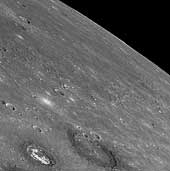|
COMETS EARTH JUPITER KUIPER BELT MARS MERCURY METEORITES NEPTUNE OORT CLOUD PLUTO SATURN SOLAR SYSTEM SPACE SUN URANUS VENUS ORDER PRINTS
PHOTO CATEGORIES SCIENCEVIEWS AMERICAN INDIAN AMPHIBIANS BIRDS BUGS FINE ART FOSSILS THE ISLANDS HISTORICAL PHOTOS MAMMALS OTHER PARKS PLANTS RELIGIOUS REPTILES SCIENCEVIEWS PRINTS
|
Related Documents
Download Options
As MESSENGER sped by Mercury on January 14, 2008, the Narrow Angle Camera (NAC) of the Mercury Dual Imaging System (MDIS) captured this image, which includes the edge of the planet against the blackness of space. Much of the foreground shows a portion of Caloris basin, one of the largest impact basins in the solar system. The two large craters near the bottom of this image can be identified on the northwestern floor of the basin on the mosaicked image of Caloris (see PIA10383) released at MESSENGER's NASA press conference on January 30. The large crater in the bottom middle of this image has a diameter of about 70 kilometers (40 miles). Caloris basin is an area of particular interest to the MESSENGER science team, since understanding its formation can lead to insights about the nature of large impacts in the early solar system and the results of these catastrophic events. In a false-color image of Mercury (see VSS00093), also released on January 30, Caloris basin is visible in the northern hemisphere of the planet as a large, light-colored, roughly circular feature; the floor of the basin may have some differences in its composition compared with the darker surrounding surfaces. The two large craters shown in today's released image are each surrounded by a "halo" of dark material, like the craters shown in our release of February 21 (see PIA10602). The smaller of the two craters has an unusual pattern of bright, highly reflective material on its floor. The fact that both of these craters, which show different material characteristics, are located within Caloris basin provides information about the variety and complexity of processes that have shaped Mercury's surface. Image Mission Elapsed Time (MET): 108826622 These images are from MESSENGER, a NASA Discovery mission to conduct the first orbital study of the innermost planet, Mercury. For information regarding the use of images, see the MESSENGER image use policy. |
